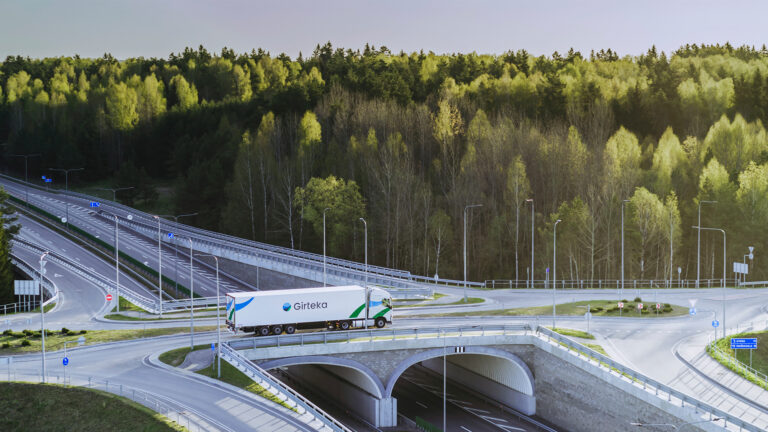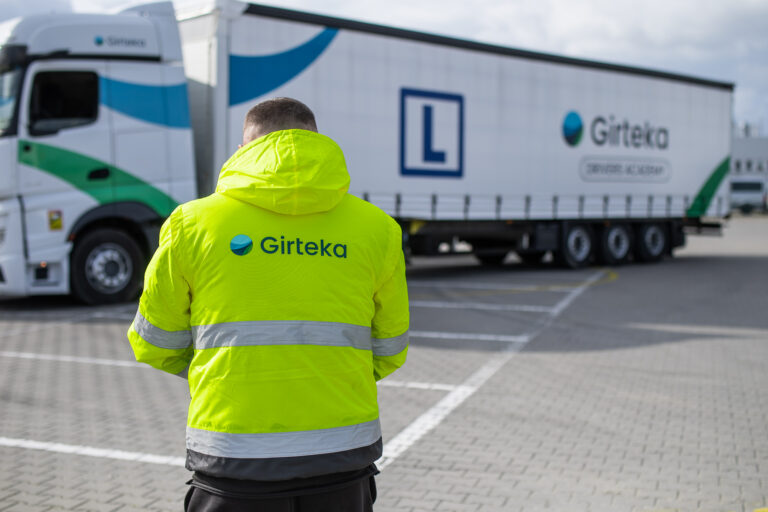Share it:
Every industry that operates today is aiming to reduce its emissions going forward and trucking is no exception to the trend. Multiple stakeholders are interested in seeing zero-emissions trucks delivering loads globally. Governments worldwide, including the European Union (EU), are enforcing stringent deadlines for achieving net-zero emissions by 2050. The question is, how much does the EU need to help certain sectors, particulary road freight transportation, to decarbonize and reach its legally binding goals?
The EU submitted its Intended National Determined Contributions (INDC) in October 2016, with a target of at least 40% economy-wide reduction of greenhouse gas emissions (GHG) by 2030, compared to 1990 levels. In December 2020, the European Council (EC) endorsed a new and more ambitious EU climate target for 2030, a net domestic reduction of at least 55% in GHG emissions by 2030 from 1990 levels. Recent updates and initiatives continue to reinforce these commitments.
Emissions Goals for the Trucking Industry
The EU’s push towards decarbonizing transport, particularly heavy-duty vehicles (HDVs), is key for meeting climate goals. HDVs contribute to over 6% of total EU GHG emissions. The EU’s strategy to tackle these emissions involves setting stringent CO2 emissions standards, which are expected to lower vehicle costs over time through economies of scale, making zero-emission vehicles (ZEVs) more affordable and attractive.
In April 2024, the EU published the revised CO2 emission standards for HDVs, stating that the new legislation “will be key to drive down emissions in the road transport sector and ensure the increasing supply of new zero-emission vehicles (ZEVs) to the market. Zero-emission HDVs currently include battery electric vehicles (BEVs), fuel-cell and other hydrogen-powered vehicles.
Under the new regulation, ambitious targets are set to reduce CO2 emissions compared to 2019 levels by: 45% from 1 January 2030; 65% from 1 January 2035; and by 90% from 1 January 2040 onwards. In addition, 90% of new urban buses in the EU will have to be zero-emissions as of 2030, and all of them by 2035. The new legislation expands the current scope to cover almost all trucks, urban buses and long-distance buses (above 7.5 tonnes) as well as trailers.
A key component of the EU’s strategy is enabling policies such as the Alternative Fuel Infrastructure Regulation, which aims to ensure a robust network of electric recharging and hydrogen refuelling stations. This infrastructure development, combined with a cleaner electricity grid as mandated by the Renewable Energy Directive, is essential for the widespread adoption of ZEVs.
Economic implications also play a pivotal role. The total cost of ownership for new HDVs is expected to decrease significantly, with projected savings of around €9,000 for vehicles purchased in 2030 and €41,000 for those in 2040. The new legislation provides a clear framework for the industry, encouraging investment in innovative technologies and infrastructure, thus maintaining the EU’s leadership in the global HDV market and supporting highly skilled employment.
The new CO2 standards will dramatically reduce fossil fuel dependency, potentially decreasing demand by approximately 2 billion barrels of oil from 2031 to 2050, enhancing the EU’s energy independence.
Emissions Targets for Truck Manufacturers
The EU Regulation 2019/1242 was the first to set CO2 emissions targets for HDVs across the entire bloc. Since it entered into force, truck manufacturers have had a clear target to achieve – beginning with the 2025 model year, CO2 emissions from heavy-duty trucks must be 15% less than the 2019/2020 reference year. The challenge, despite the bloc’s lawmakers’ conclusion that it is achievable with current means, is not an easy one.
The industry, still fragmented with many small to medium-sized enterprises (SMEs), has shown incremental progress in updating fleets. However, economic and logistical challenges persist, highlighting the need for more robust support and incentives. Despite some companies, such as Girteka having over 6,000 trucks that are on average 2 years old, trucks in the EU are on average 13.9 years old as of 2020, per the European Automobile Manufacturers’ Association (ACEA).
The 2025 deadline is approaching fast, and truck manufacturers will have to act one way or another. The easiest (and hardest) way to reduce their fleet emissions would be to introduce ZEVs, which, even with upcoming regulations regarding brakes, tires, and battery longevity, drastically cut the number of pollutants of the total fleet.
It is the easiest way, due to the fact that zero-emissions vehicles, as their name suggests, do not emit much in terms of CO2 or any other particles. It is the hardest due to the current technological limitations, as well as the limited infrastructure available throughout the continent, which could curb operators’ enthusiasm for ordering the pricier trucks.
Nevertheless, first examples of ZEVs being utilized in real life scenarios can already be observed. Latest tests, conducted by Girteka, Nestlé, bp pulse, Volvo Trucks, and Schmitz Cargobull, are proving that a fully electric truck and trailer unit is a doable concept. One that can contribute significantly to the reduction of emissions on short distance operations.
Europe’s Interest in Solving the Infrastructure Problem
But why are road freight companies hesitant to order a larger number or perhaps even switch entirely to electric trucks?
To build a strong and resilient Single market, the EC sees increasing “investment in transport infrastructure across the EU Member States”, and by 2050, complete “a fully operational, multimodal, Trans-European Transport Network (TEN-T) for sustainable and smart transport with high-speed connectivity”.
“The lack of publicly accessible charging and refuelling infrastructure dedicated to trucks is viewed as a primary roadblock to a faster transition and fleets would welcome additional support from other stakeholders to plan the build-out of infrastructure,” read an executive summary of a report, conducted by the International Council on Clean Transportation (ICCT) and European Clean Trucking Alliance (ECTA), the latter of which Girteka is part of.
Other key issues were the manufacturers’ ability to produce enough trucks to scale an operator’s fleet quickly and the lack of diverse options for long-haul trucking operations, highlighted the survey released in September 2022.
Nevertheless, manufacturers have been expanding their manufacturing capabilities and at the same time, introducing new options to the market. The question of infrastructure persists and draws a shadow over the near-term future of a zero-emissions transport sector.
After all, building up infrastructure is much more complex than installing a charging station, especially for long-distance trips for HGVs, which can travel up to or even more than 1,000 kilometres (km) to deliver a single load.
“Current battery-electric truck models have driving ranges limited to 250–300 km, creating significant operational challenges for high mileage use cases”, noted the report by the ICCT and ECTA. Recent technological developments increase this distance up to 500 km. However, while BEVs are perfectly suited for round trips, where charging infrastructure would be readily available at both ends, the issue of long-distance deliveries remains unsolved.
On top of that, the mobility package is limiting the ability to efficiently plan utilization of trucks, as trucks and/or drivers must return every few weeks to the country of employment or registration. Sure, electric trucks do not require the same amount of attention as their Internal Combustion Engine (ICE) counterparts, but tires, brakes, and other wear and tear items have to be looked at continuously.
The development of TEN-T or Trans-European Transport Network could very well alleviate the problem, especially if it is coupled with building other trucking-related infrastructure for drivers as parking facilities or accommodations. According to the EC’s Fit For 55 alternative fuel infrastructure regulation explanatory, a recharging station would be found every 60 km, including “one recharging station in each safe and secure parking area” for trucks, specifically. Moreover, hydrogen refuelling stations would be built every 200 km, with more stations in urban areas by the end of 2030.
Solving the infrastructure problem with the development of TENT-T, which ranges from the very north of Sweden to the southernmost points in Portugal, Spain, Italy, and Greece, would significantly improve the attractiveness of ZEVs, especially battery-powered trucks, which still lack the range to complete proper A to B distances on a single charge. After all, a typical international transportation journey was 611 km, while cross-trade transport was 746.4 km in 2022, according to Eurostat data.
More EU Support Needed?
Recent collaborations between governments, manufacturers, and logistics companies underscore the importance of joint efforts in building infrastructure. Continued support and strategic partnerships will be crucial in achieving the EU’s climate goals. The EU is also seemingly interested in addressing the issue with its TEN-T development plans, which would result in a commitment from several interested parties to build infrastructure for ZEVs.
After setting goals for manufacturers and seemingly telling them to figure out the best way to achieve the goals of reducing overall new fleet emissions by 2025, then by 2030, completely eliminating them by 2050, governmental figures set out to help the sector establish charging and refuelling stations for environmentally friendly trucks.
The collective efforts of stakeholders have already shown promising results. Moving forward, sustained collaboration will be essential to accelerate the EU’s transition towards climate-neutral transportation, ensuring the ambitious targets for 2030 and 2050 are met. As the targets are clear, the technology is there, all that is needed is implementation, and that is the area where the EU’s support would be most appreciated by transport operators, namely, charging infrastructure development.



